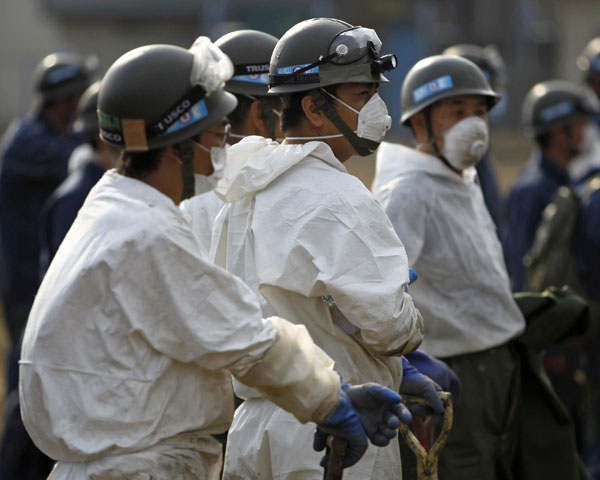Photos
First search inside Japan exclusion zone
Updated: 2011-04-15 17:04
(Agencies)
|
|
|
|
TOKYO - Hundreds of police hunted Thursday for up to 1,000 bodies believed buried in rubble near Japan's tsunami-flooded nuclear plant, searching for the first time within a narrow circle around the radiation-leaking complex.
Police said falling radiation levels have allowed them to go inside a six-mile (10-kilometer) radius at the Fukushima Dai-ichi plant for the first time, as they search for thousands of victims still missing after the March 11 earthquake and tsunami.
"We need to work very carefully so as not to rip our radiation suits with the debris, metal and chunks of concrete scattered everywhere in the zone," a police officer who gave only his surname, Sato, said in a telephone interview.
Although Japanese officials have insisted the situation at the crippled plant is improving, the crisis has dragged on, accompanied by a nearly nonstop series of mishaps and aftershocks of the 9.0-magnitude quake that have impeded work in clearing debris and restoring the plant's disabled cooling systems.
The setbacks are angering and frustrating residents whose lives have been derailed by the crisis.
"I'm physically and mentally worn out," said Yoshihisa Kato, a 66-year-old noodle shop owner in the town of Kawamata, which is about 28 miles (45 kilometers) northwest of the plant and in an area to be evacuated over radiation concerns.
"I've been going to funerals almost everyday because many elderly people in my neighborhood have died due to shocks and exhaustion," said Kato, whose business has dried up as residents have fled the area.
Japan acknowledged this week that overall leaked radioactivity already has catapulted the crisis into the highest severity on an international scale, on a par with Chernobyl, though still involving only a tenth of the radioactivity emitted in that 1986 disaster.
A 102-year-old man committed suicide Tuesday, a day after the government included Iitate, the village where he had lived all his life, as an area to be evacuated to avoid radiation exposure. A local police official, who declined to be named because he was not authorized to speak to media, confirmed the man had killed himself but would give no further details.
In a zone near the plant where up to 1,000 bodies are believed lodged in tsunami debris, police in white suits gingerly picked through rubble, Sato said. Overall, more than 26,000 people are believed to have died in the March 11 disaster, though only about 11,250 bodies have been recovered so far. Nearly 140,000 people are still living in shelters after losing their homes or being advised to evacuate.
"Many families have asked us to search for their missing loved ones. I want to recover bodies as quickly as possible and hand them over to their families," Sato said.
A glitch in cooling spent fuel at one of the plant's reactor buildings resulted in a temporary surge in radiation this week. Water inadvertently sprayed into an overflow tank prompted a false reading that the main pool was full when it wasn't. That prompted workers to suspend the injection of water into the main pool for several days until Wednesday, when spraying resumed.
Strong aftershocks might also have affected the readings, officials said.
The suspension of spraying allowed temperatures and radiation levels to rise, though the rods were still believed to have been covered with water, said Hidehiko Nishiyama of Japan's Nuclear and Industrial Safety Agency.
"I believe fuel rods in the pool are largely intact, or still keeping the normal shape of what they should look like," Nishiyama said Thursday. "If they were totally messed up, we would have been looking at different sets of numbers from the water sampling."
Three of the plant's reactors also have about 20,000 metric tons of stagnant, radiation-contaminated water and it is proving difficult to reduce the amount spilling from the reactors, Nishiyama said.
Until cooling systems can be fully restored, flooding the reactors with water is the only way to help prevent them from overheating, but those many tons of water, tainted with radioactivity, pose a separate threat.
"It is the problem of being stuck with reactors that constantly need to be fed water," Nishiyama said. Setbacks in preparing tanks to store the contaminated water mean new options may need to be considered, he said. He did not elaborate.
The beleaguered plant operator, Tokyo Electric Power Co, or TEPCO, is seeking ways to eventually remove spent fuel rods from reactor storage pools as the plant is closed down for good. The glitch at Unit 4 makes those plans more urgent.
Eventually the rods must be stored permanently in dry, radiation-proof casks, but that process is far off, he said.
TEPCO, meanwhile, is working to stabilize conditions at the plant's No. 1 reactor by pumping nitrogen into its containment vessel to reduce risks of a hydrogen explosion. It also is installing steel plates and silt screens along the coast to help reduce radiation leaks into the sea.
E-paper

Han me downs
Traditional 3,000-year-old clothes are making a comeback.
Reaching out
Fast growth fuels rise in super rich
Chinese tourists spend more
Specials

Big spenders
More mainland tourists are expected to spend money on overseas travel this year.

Rise in super rich
Report cites rising property prices, gdp as key drivers of increasing number of chinese millionaires.

Reaching out
Condom makers are stepping up their presence in smaller cities to boost sales


